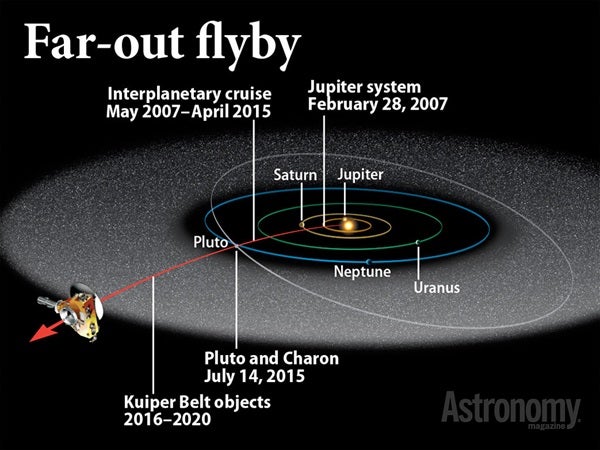Because New Horizons has so much important data to collect, it can’t focus its precious energy on delivering information back to Earth in real time. Instead, it will actually be incommunicado for most of the day July 14. Only later will downlinking begin.
Astronomy.com will have complete continuous coverage starting just before 7:30 a.m. EDT July 14 in our shared live blog with Discover magazine (you’ll find the live blog at the top of our Pluto coverage at that time), but here’s a brief timeline of what you can expect (and when). It’s important to note that although we know when some data will arrive on Earth, that doesn’t mean it will be made public that moment. The New Horizons team will release the data and images on their own schedule.
July 13
11:15 p.m. EDT: Mission scientists will receive the best single-frame photo of Pluto (likely to be released the morning of the flyby).
July 14
7:30 a.m. EDT: NASA TV will broadcast an “Arrival at Pluto Countdown Program.” While at the moment (and for much of the day) New Horizons will not be in contact with Earth, this broadcast will still be an initial celebration of this historic moment in space exploration and a briefing on what’s expected from the spacecraft. Official closest approach occurs at 7:49:58 a.m. EDT. After that, three key milestones occur that will be focuses for data collection. Some 14 minutes later, New Horizons will make its closest approach to Pluto’s largest moon, Charon. The main events after that will be when Pluto and then Charon pass directly in front of the Sun from New Horizons’ perspective, which will allow the mission to gather data on Pluto’s atmosphere and see if Charon has one.
1:00 p.m. EDT: NASA TV will broadcast “The Year of Pluto” documentary.
8:30 p.m. EDT: NASA TV will broadcast a Pluto party as New Horizons is expected to phone home to Earth with word that it successfully survived the flyby. The message should be received right around 9 p.m. EDT.
July 15
6:59 a.m. EDT: In its “First Look A” downlink, the New Horizons team will receive initial data, including the best single-frame photo of Charon, a stereo view of Pluto, and the best image of the small moon Hydra.
3 p.m. EDT: NASA TV will host a media briefing that will include the release of the best Pluto close-up images.
3:25 p.m. EDT: Mission control will receive the best photo of the small moon Nix that New Horizons has as well as the highest-resolution images of Pluto as part of the “First Look B” downlink.
July 16
3:23 a.m. EDT: The “First Look D” downlink (“First Look C” will come slightly earlier and feature no imagery) will feature the highest-resolution images of Charon.
9:22 a.m. EDT: The final “First Look” downlink will include a color portrait of Pluto and Charon in the same image.
July 17–20
All other “High Priority” data and images will be downlinked before a hiatus of images until September 14.










